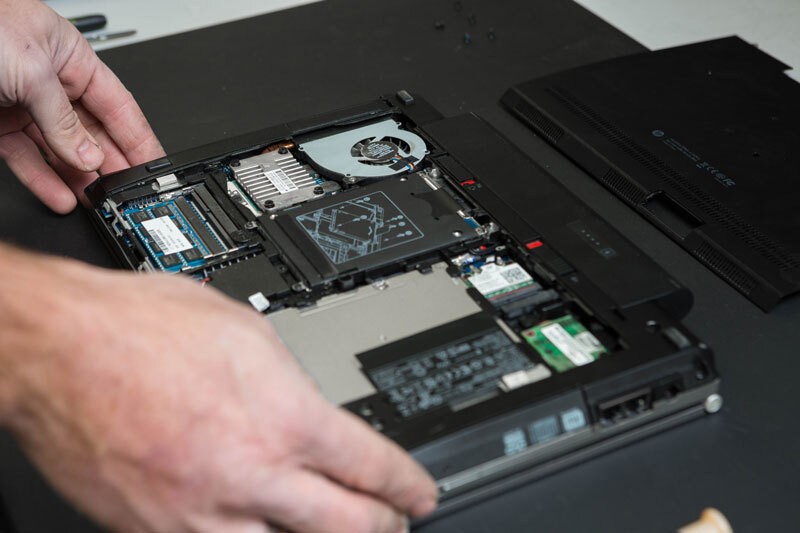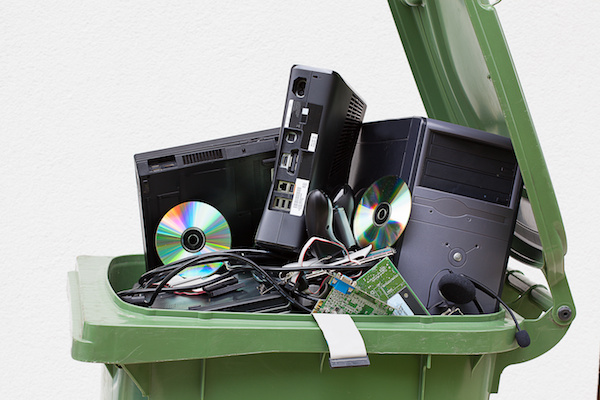
Expert Solutions for Responsible Data Destruction
In the age of digital technology, protecting sensitive data and minimizing environmental impact are crucial aspects of any business. Effective IT asset disposal plays a vital role in achieving both these objectives. Join us as we explore the importance of IT asset disposal, best practices, and how to choose the right service provider to ensure data security and environmental sustainability.
Key Takeaways
- IT Asset Disposal is an important process that must be handled by specialists to ensure data protection, cost-effectiveness and eco-friendly practices.
- Secure data destruction methods such as shredding, degaussing, wiping and encryption are employed for maximum security against unauthorized access.
- Legal aspects of IT asset disposal involve adhering to applicable regulations while maximizing value recovery through remarketing usable assets or recycling unusable equipment.
Understanding IT Asset Disposal: Importance and Process

IT Asset Disposal (ITAD) enables organizations to monetize decommissioned IT assets, thus providing a return on investment. Specialist ITAD companies, like an it asset disposal company, manage the complete lifecycle of these assets, from collection to recycling and final asset disposals. The necessity of these asset disposal services arises from various factors such as adherence to data protection laws, cost-effectiveness, and eco-friendly practices.
Employing an ITAD company guarantees the secure management of data-bearing devices like:
- computers
- smartphones
- laptops
- data tapes
- hard drives
Such companies uphold stringent security standards throughout the disposal process with vetted personnel overseeing the operations. These services assist organizations in maintaining GDPR compliance, achieving sustainability goals, and ensuring the secure disposal of data-bearing equipment.
Book Your ITAD Collection Here
The Role of IT Asset Disposal in Data Security
The role of IT asset disposal in data security is significant. During the relocation or disposal of IT assets, tracking data-bearing assets is imperative to avoid unauthorized data access. Secure erasure or destruction of data-bearing devices ensures complete elimination of personal data, thereby maintaining compliance with data protection laws.
Maintaining compliance with data protection laws is a must to ensure the secure management and disposal of personal data. A well-executed IT asset disposal process safeguards sensitive data while conforming to data protection regulations like GDPR, HIPAA, or PCI-DSS, helping organisations avert possible data breaches and consequential financial and reputational losses.
Environmental Impact of IT Asset Disposal
Sustainable IT asset disposal is advantageous as it:
- Ensures compliance with GDPR regulations
- Encourages the circular economy
- Minimizes environmental impact
- Promotes environmental stewardship and data security
Adopting environmental sustainability practices helps organizations circumvent heavy fines and potential brand damage resulting from improper disposal and e-waste.
Companies adhering to an environmentally responsible approach during IT asset disposal can achieve impressive near-zero landfill rates, surpassing the 16% target set by the Environment Agency. Sustainable practices employed in IT asset disposal include:
- Prolonging the lifespan of corporate assets
- Safely recycling IT assets
- Embracing the circular economy
- Recycling electronics
- Refurbishing IT assets
- Ensuring secure data destruction
- Conducting a hardware audit
- Implementing IT asset disposition programs.
Choosing the Right IT Asset Disposal Service Provider
Choosing the right ITAD service provider ensures adherence to best practices, including secure data destruction and responsible recycling, leading to enhanced service quality. When selecting a provider, consider key factors like accreditation, regulatory compliance, and the data destruction methods they employ.
Accreditation and Compliance
When choosing an ITAD service provider, it’s important to check their accreditation and regulatory compliance. Adherence to industry standards and regulations ensures quality management, data security, environmental compliance, and privacy protection. For IT asset disposal companies, the most relevant industry accreditation and compliance standards are ISO 9001, ISO 27001, ISO 14001, e-Stewards certification, and adherence to UK GDPR and WEEE regulations.
By adhering to ISO 14001:2015, IT asset disposal companies can enhance their environmental performance and guarantee responsible disposal of IT assets. Compliance with GDPR regulations is essential to safeguard the privacy and rights of EU citizens. Engaging with an accredited and compliant ITAD service provider ensures secure and responsible disposal of your organization’s IT assets.
Book Your ITAD Collection Here
Secure Data Destruction Methods
Various secure data destruction methods are employed by IT asset disposal companies to ensure data security. These methods include:
- Shredding: This is the most secure option as it physically destroys the drives through an industrial machine.
- Degaussing: This method utilizes a strong magnetic field to erase data from magnetic storage devices.
- Wiping: This involves software-based data erasure.
These methods guarantee that the data is irreversibly destroyed and cannot be recovered.
Encryption is another essential aspect of secure data destruction during IT asset disposal. Data stored in an encrypted format remains unreadable and unusable without the encryption key, providing an added layer of security during the disposal process. Thus, even if the physical storage media is obtained by unauthorized personnel, the data remains protected and inaccessible, ensuring data secure.
Maximizing Value from IT Asset Disposal

Strategies to extract maximum value from IT asset disposal can include remarketing IT assets and recycling unusable equipment. Remarketing helps increase recoverable value, reduces the demand for new production, boosts resale value, and diminishes the total cost of ownership during asset disposal. This approach not only contributes to the overall value of the disposal process but also promotes sustainability by reducing waste and the demand for new raw materials.
Recycling IT equipment brings several environmental benefits such as repurposing of discarded equipment, reducing air pollution, diminishing landfill usage, and lessening the adverse effects of e-waste on the environment and human health. IT equipment recycling typically yields tin, silicon, iron, aluminum, various types of plastic, glass, and precious metals, which can then be utilized in future production processes. By incorporating recycling services for unusable IT equipment, organizations can achieve an optimal balance between asset recovery and environmental responsibility.
Remarketing of IT Assets
Remarketing IT assets entails assessing the resale potential of devices based on age and functionality, assembling the assets, and selling them to new users to recoup some of the initial investment. Often, PCs and monitors, laptops, tablets, networking equipment, projectors, other A/V equipment, and mobile phones are considered suitable for remarketing.
Remarketing IT assets can provide direct cost savings and predictable returns. It enables businesses to realize cost savings by selling or refurbishing retired IT assets instead of disposing of them. Moreover, it offers a cost-effective alternative to acquiring new equipment, particularly for businesses with budgetary restrictions. By following best practices such as formalized, written consignment agreements, working with certified providers, prioritizing data security and sustainability, performing audits and inspections, and seeking expert advice on timing, organizations can maximize the return from remarketing IT assets.
Recycling Services for Unusable IT Equipment
Recycling services for non-functional IT equipment, including waste electrical and electronic equipment, play a significant role in lessening environmental impact and fostering sustainability. IT equipment that can be recycled includes:
- Computer base units
- Printers
- Routers
- Laptops
- Whiteboards
- CRT monitors
- TVs
- Networking equipment
- CMOS battery
- Motherboards
- CPU
- Hard drive
- Optical drive
- Cables
Recycling IT equipment contributes to sustainability by:
- Decreasing the need for obtaining raw materials
- Preventing hazardous materials from polluting the environment
- Lowering energy utilization and waste
- Reclaiming valuable materials via recycling
- Cutting down electronic waste
By incorporating recycling services into the IT asset disposal process, organizations can ensure a holistic approach to asset management that maximizes value recovery while minimizing environmental impact. Utilizing IT disposal services can further enhance this approach.
Book Your ITAD Collection Here
Ensuring a Seamless IT Asset Disposal Experience

A smooth IT asset disposal experience requires maintaining an audit trail and asset traceability throughout the process, complemented by convenient collection and transportation arrangements. These key elements not only streamline the disposal process but also ensure data security and compliance with relevant regulations. By adopting these best practices, organizations can achieve a smooth and efficient IT asset disposal experience that maximizes value and minimizes risks.
A comprehensive audit trail and traceability ensure transparency, accountability, and adherence to regulations and policies concerning IT asset disposal.
Convenient collection and transportation arrangements, including:
- flexible shipping options
- optimal asset utilization
- enhanced security measures
- integrated asset management
- digital solutions
Further simplify the process and ensure a seamless IT asset disposal experience.
Audit Trail and Traceability
An audit trail in the context of IT asset disposal is a documentation and record-keeping process that tracks the disposal of IT assets. It provides a comprehensive account of the disposal activities, such as the date, time, method, and responsible party involved in the disposal process. The audit trail ensures transparency, accountability, and adherence to regulations and policies concerning IT asset disposal.
Traceability in IT asset disposal provides numerous advantages, such as:
- Enabling companies to track and document the movement and disposal of assets
- Maximizing value recovery
- Mitigating risks
- Promoting sustainability
- Ensuring that IT asset disposition is handled correctly
Additionally, it helps to minimize waste and the demand for new raw materials by allowing resources to be properly recovered, repurposed, or recycled. Technologies such as RFID and QR codes are often employed for traceability in IT asset disposal.
Convenient Collection and Transportation Options
IT asset disposal service providers typically utilize various collection methods, such as collection and tracking, secure separation, data destruction, asset tracking, and proper disposal services. The procedure for transporting IT assets during the disposal process includes preparing the assets for collection, organizing transportation to the disposal site, and recording transportation details. By employing IT asset disposal services, companies can ensure the secure and responsible handling of their IT assets.
When transporting IT assets for disposal, special precautions may include:
- The use of hoists or lifting equipment on vehicles
- Proper storage and separation of assets
- Adherence to waste disposal regulations
- Verification of the working condition of the equipment
These precautions ensure that the IT assets are transported securely and responsibly, minimizing the risk of data breaches and environmental damage during the disposal process.
Legal and Regulatory Aspects of IT Asset Disposal
Legal requirements for IT asset disposal involve adherence to data protection laws, like GDPR, and regulations specific to e-waste disposal. Tracking and documenting the disposal process and choosing a dependable partner for disposal, recycling, or reselling of assets is vital. Compliance with GDPR regulations is essential to safeguard the privacy and rights of EU citizens.
When disposing of IT assets, it is essential to:
- Comply with industry, data privacy, environmental, and waste management regulations
- Adhere to company environmental policies and green initiatives
- Practice responsible disposal to prevent data security breaches and comply with environmental regulations
Consulting legal and environmental experts is recommended to ensure full compliance with applicable regulations.
Proper IT asset disposal is essential for data security, environmental sustainability, and regulatory compliance. By understanding the importance and process of IT asset disposal, selecting the right service provider, maximizing value through remarketing and recycling, and ensuring a seamless disposal experience, organizations can protect sensitive data, minimize environmental impact, and maintain compliance with legal and regulatory requirements.
Frequently Asked Questions
What is the IT asset disposal process?
The IT asset disposal process involves securely tracking an asset until it is properly disposed of, which could be done by reusing, recycling, repurposing, repairing, or securely destroying the unwanted equipment. Depending on the asset, this could involve wiping it with NCSC (previously CESG) NIST approved software or physically shredding it, and always certifying that it has been destroyed correctly.
What is an example of IT asset disposal policy?
An example of an IT asset disposal policy is that any IT equipment reaching its “end of life” must have its data securely deleted/wiped and sensitive data deemed unreadable and unrecoverable before redistribution or reuse within the organisation. Staff must also be notified of any equipment that’s no longer required and ensure correct disposal with data deletion.
What is the meaning of asset disposal?
Asset disposal is the process of removing a long-term asset from a company’s financial records, such as by selling or scrapping it. It is an important concept since capital assets are essential to successful business operations and proper accounting of the disposal of an asset is necessary to maintain clean accounting records.
What are the main reasons for proper IT asset disposal?
Proper IT asset disposal is essential for compliance with data protection regulations, cost savings, and environmental protection.
How can I ensure that my organisation’s sensitive data is securely disposed of during IT asset disposal?
To ensure your organisation’s sensitive data is securely disposed of during IT asset disposal, partner with an IT asset disposal service provider that offers secure data destruction methods and maintains a comprehensive audit trail.

